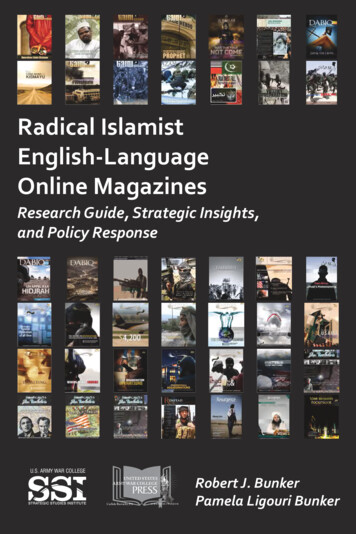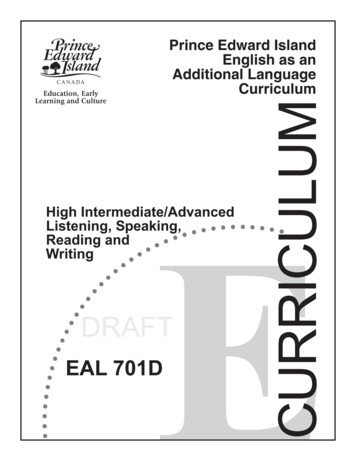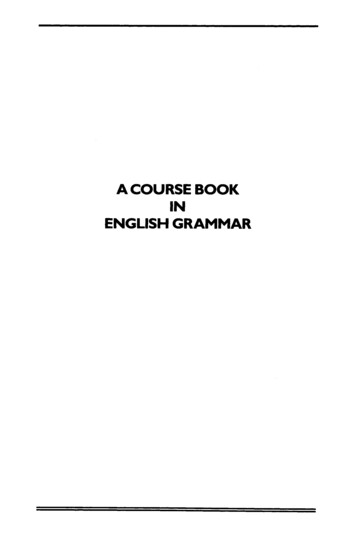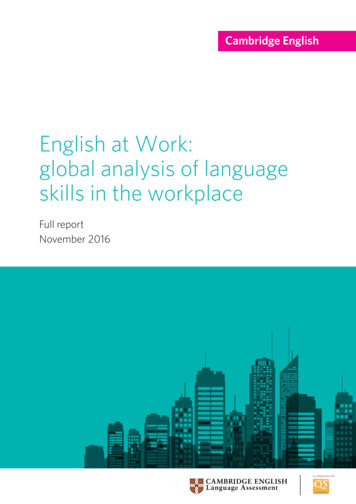
Transcription
Radical IslamistEnglish-LanguageOnline MagazinesResearch Guide, Strategic Insights,and Policy ResponseU.S. ARMY WAR COLLEGERobert J. BunkerPamela Ligouri Bunker
The United States Army War CollegeThe United States Army War College educates and develops leaders for serviceat the strategic level while advancing knowledge in the global applicationof Landpower.The purpose of the United States Army War College is to produce graduateswho are skilled critical thinkers and complex problem solvers. Concurrently,it is our duty to the U.S. Army to also act as a “think factory” for commandersand civilian leaders at the strategic level worldwide and routinely engagein discourse and debate concerning the role of ground forces in achievingnational security objectives.The Strategic Studies Institute publishes nationalsecurity and strategic research and analysis to influencepolicy debate and bridge the gap between militaryand academia.CENTER forSTRATEGICLEADERSHIPU.S. ARMY WAR COLLEGEThe Center for Strategic Leadership contributesto the education of world class senior leaders,develops expert knowledge, and provides solutionsto strategic Army issues affecting the nationalsecurity community.The Peacekeeping and Stability Operations Instituteprovides subject matter expertise, technical review,and writing expertise to agencies that develop stabilityoperations concepts and doctrines.The School of Strategic Landpower develops strategicleaders by providing a strong foundation of wisdomgrounded in mastery of the profession of arms, andby serving as a crucible for educating future leaders inthe analysis, evaluation, and refinement of professionalexpertise in war, strategy, operations, national security,resource management, and responsible command.The U.S. Army Heritage and Education Center acquires,conserves, and exhibits historical materials for useto support the U.S. Army, educate an internationalaudience, and honor Soldiers—past and present.i
STRATEGICSTUDIESINSTITUTEThe Strategic Studies Institute (SSI) is part of the U.S. Army WarCollege and is the strategic-level study agent for issues relatedto national security and military strategy with emphasis ongeostrategic analysis.The mission of SSI is to use independent analysis to conductstrategic studies that develop policy recommendations on: Strategy, planning, and policy for joint and combinedemployment of military forces; Regional strategic appraisals; The nature of land warfare; Matters affecting the Army’s future; The concepts, philosophy, and theory of strategy; and, Other issues of importance to the leadership of the Army.Studies produced by civilian and military analysts concerntopics having strategic implications for the Army, the Department ofDefense, and the larger national security community.In addition to its studies, SSI publishes special reports on topicsof special or immediate interest. These include edited proceedingsof conferences and topically oriented roundtables, expanded tripreports, and quick-reaction responses to senior Army leaders.The Institute provides a valuable analytical capability within theArmy to address strategic and other issues in support of Armyparticipation in national security policy formulation.iii
Strategic Studies InstituteandU.S. Army War College PressRADICAL ISLAMIST ENGLISH-LANGUAGEONLINE MAGAZINES: RESEARCH GUIDE,STRATEGIC INSIGHTS, AND POLICYRESPONSERobert J. BunkerPamela Ligouri BunkerAugust 2018The views expressed in this report are those of the authors anddo not necessarily reflect the official policy or position of theDepartment of the Army, the Department of Defense, or theU.S. Government. Authors of Strategic Studies Institute (SSI)and U.S. Army War College (USAWC) Press publications enjoyfull academic freedom, provided they do not disclose classifiedinformation, jeopardize operations security, or misrepresentofficial U.S. policy. Such academic freedom empowers them tooffer new and sometimes controversial perspectives in the interestof furthering debate on key issues. This report is cleared for publicrelease; distribution is unlimited. This publication is subject to Title 17, United States Code, Sections101 and 105. It is in the public domain and may not be copyrighted.v
Comments pertaining to this report are invited and should beforwarded to: Director, Strategic Studies Institute and U.S. ArmyWar College Press, U.S. Army War College, 47 Ashburn Drive,Carlisle, PA 17013-5238. This manuscript was funded by the U.S. Army War CollegeExternal Research Associates Program. Information on thisprogram is available on our website, http://ssi.armywarcollege.edu/,at the Opportunities tab. All Strategic Studies Institute (SSI) and U.S. Army WarCollege (USAWC) Press publications may be downloaded freeof charge from the SSI website. Hard copies of certain reportsmay also be obtained free of charge while supplies last by placingan order on the SSI website. Check the website for availability.SSI publications may be quoted or reprinted in part or in fullwith permission and appropriate credit given to the U.S. ArmyStrategic Studies Institute and U.S. Army War College Press,U.S. Army War College, Carlisle, PA. Contact SSI by visiting ourwebsite at the following address: http://ssi.armywarcollege.edu/. The Strategic Studies Institute and U.S. Army War CollegePress publishes a quarterly email newsletter to update the nationalsecurity community on the research of our analysts, recent andforthcoming publications, and upcoming conferences sponsoredby the Institute. Each newsletter also provides a strategiccommentary by one of our research analysts. If you are interestedin receiving this newsletter, please subscribe on the SSI website atthe following address: http://ssi.armywarcollege.edu/newsletter/.vi
The authors would like to express their thanks to the MiddleEast Media Research Institute (MEMRI) for providing access tocopies of some of the lesser-known online magazines for researchsupport purposes.ISBN 1-58487-784-7vii
FOREWORDThis unique Strategic Studies Institute (SSI)resource, authored by Robert J. Bunker and PamelaLigouri Bunker—both of whom possess considerablecounterterrorism analytical expertise—required manymonths of sustained research, analysis, and writingto produce. Simply collecting and cataloging the initial publication dataset itself represented a time-consuming process. As a result, this new research guideconstitutes the most comprehensive work done to dateon radical Islamist English-language online magazinesfor U.S. military educational and applied responsepurposes. This topical area is of great importance tothe U.S. Army—and our national security posture ingeneral—due to the association these magazines havewith radical Islamist propaganda and recruitment,migration (hijrah) to Syria and Iraq, and attacks on theWest utilizing “open source jihad (OSJ)” and later “justterror” techniques.This book discusses and analyzes the more wellknown radical Islamist English-language online publications—al-Qaeda’s Inspire magazine, the pro-TalibanAzan magazine, and the Islamic State’s (IS) Dabiq magazine—as well as a number of lesser-known publications associated with al Shabaab (Gaidi Mtaani andAmka) and al-Nusrah Front (Al-Risalah). Additionally,early Islamist works such as Benefit of the Day, JihadiRecollections, and Defenders of the Truth are highlighted.Further, Inspire guides and special theme publicationsand IS reports, news, and little-discussed eBooks—theBlack Flags, Shudada (Martyrs), Islamic State, and TheWest series—are addressed. It next offers a comparative analysis of basic narratives found in 30 combinedissues of Inspire and Dabiq magazines. Al-Qaeda andix
IS online magazine clusters are then provided alongwith a discussion of the differing strategic approachesof these transnational terrorist organizations. Finally,policy response options are offered as a counter to theemergence of these publications, a detailed radicalIslamist online magazine chronology has been constructed, and a glossary of Arab terms found in the twodominant magazines is provided.SSI hopes this unique research guide focusing onradical Islamist English-language online magazines(and many lesser-known guides and eBooks), and thestrategic insights and policy response recommendations found within it, will be of great interest to U.S.Army organizations engaged in offensive and defensive operations against these terrorist entities as wellas to the broader U.S. strategic community, especiallywithin counterterrorism and homeland securityfocused agencies.DOUGLAS C. LOVELACE, JR.DirectorStrategic Studies Institute andU.S. Army War College Pressx
ABOUT THE AUTHORSROBERT J. BUNKER is an international security andcounterterrorism professional and is presently an adjunct research professor at the Strategic Studies Institute (SSI) of the U.S. Army War College (USAWC)and an instructor with the Safe Communities Institute,University of Southern California. Past associations include Futurist in Residence, Behavioral Research andInstruction Unit at the Federal Bureau of Investigation(FBI) Academy in Quantico, VA and DistinguishedVisiting Professor and Minerva Chair at SSI, USAWC.Dr. Bunker holds university degrees in political science, government, social science, anthropology-geography, behavioral science, and history and has undertaken hundreds of hours of specialized counterterrorism and counternarcotics training. He has deliveredhundreds of presentations—including U.S. Congressional Testimony—and has hundreds of publicationsincluding numerous books, booklets, reports, papers,articles, response guidance, and research notes. Radical Islamist-focused publications and activities include co-editorship of a recent five-volume Small WarsJournal anthology series on this topical area as wellas earlier works ranging from the weaponization ofunmanned aerial systems (UAS), use of teleoperatedsniper rifles and machine guns, and suicide bombers(including internal body cavity), along with related efforts extending back to pre-9/11 research on al-Qaeda doctrine, later published for U.S. law enforcementcounterterrorism purposes, as well as pre- and post9/11 Los Angeles Terrorism Early Warning Group (LATEW) activities.xi
PAMELA LIGOURI BUNKER is a researcher andanalyst specializing in international security and terrorism—with a narratives analytical focus—and ispresently a non-resident fellow in terrorism and counterterrorism, TRENDS Research and Advisory, AbuDhabi and an associate with Small Wars Journal—ElCentro. She is a past senior officer of the Counter-OPFOR Corporation and has professional experiencein research and program coordination in university,non-governmental organization (NGO), and city government settings. She holds undergraduate degreesin anthropology-geography and social sciences fromCalifornia State Polytechnic University Pomona, anM.A. in public policy from the Claremont GraduateUniversity, and an M.Litt. in terrorism studies fromthe University of Saint Andrews, Scotland. She is aco-editor of Global Criminal and Sovereign Free Economies and the Demise of the Western Democracies: DarkRenaissance (Routledge, 2015) and has published anumber of referred and professional works—individually and co-authored—in Small Wars & Insurgencies,Small Wars Journal, FBI Library Subject Guides, and invarious edited book projects including Narcos Over theBorder (Routledge, 2011) and Criminal-States and Criminal-Soldiers (Routledge, 2008). She is currently engagedin research projects related to the Islamic State (IS)online magazine Rumiyah and “just terror” activities,strategies to mitigate IS foreign fighters from returningto their homelands, and the effects of rising economicinequality in the United States and the United Kingdom and its Armed Forces employment implications.xii
SUMMARYRadical Islamist online magazines first appeared inNovember 2003 with the publication of Sawt al-Jihad(Voice of Jihad) in Arabic. This magazine discontinuedpublication in April 2005 after 29 issues, having beenshut down by the Saudi security services. The magazine was produced by the Saudi branch of al-Qaedathat later evolved into al-Qaeda in the Arabian Peninsula (AQAP). It called upon other al-Qaeda groups todevelop and franchise their own magazines. Besidesthe plethora of radical Islamist online magazines inArabic that has been produced since 2003—alongwith those in many other languages including Urdu,Russian, German, French, and Turkish—English-language editions have been in existence since April-May2007. There have been a number of these magazinespublished at varying dates and for varying periods oftime. Some, such as Al Rashideen and Ihya-e-Khilafat,were initiated but fell by the wayside, victim to a lackof audience, the capture or death of an editor, or theirinitiating group’s evolution. In the cases of al-Qaeda’sInspire and Islamic State’s Dabiq magazines, the publications have been ongoing—until very recently withthe demise of Dabiq—with over a dozen issues each,and have notably been cited in relation to terrorismcases by law enforcement. Beyond their propagandapotentials, each magazine can be said to promote aspecific jihadi culture, to be embraced in total by followers of the particular group in question in order toachieve its desired utopian vision. Toward that end,components of these online magazines address thegroup’s successes and legitimacy, offer a vision of adesirable end state, encourage recruitment into theirranks, direct violent action against stated enemies,xiii
and provide instructional materials and advice withregards to its enaction.The fact that an online magazine-style format hasbeen used across groups over a notable period of timeand the availability of a comprehensive data set of theissues of these magazines, both current and archived,is believed to provide a unique opportunity for evaluation of the nature of the threat these organizationspotentially pose. It is not surprising, then, that theappearance and ongoing publication of English-language based magazines have caught the attention ofscholars and counterterrorism researchers who haveanalyzed the better-known series of these magazinesin numerous manuscripts, reports, and articles. Whereuseful, these works have been cited in the magazinedatabase that follows. In reviewing the work doneto date on radical Islamist English-language onlinemagazines, however, efforts toward the analysis ofonline radical jihadist media in general—and onlineEnglish-language magazines in particular—have beenpiecemeal. The results fall into three main categories:single magazine generalizations, comparisons betweenmagazines, and those—largely popular media—piecesconnecting these magazines to violent action.In investigating these radical Islamist English-language online magazines and the body of work surrounding them, the authors determined that therewas no document available in open-source form providing a comprehensive overview of this magazinegenre, along with their predecessors and offshootEnglish-language periodicals. In addition, none of theexisting studies provided a thorough look at the entirecontents of Inspire and Dabiq—as the two then-primaryongoing publications—in a way that would be usefulxiv
to U.S. military and governmental researchers andpolicymakers.The focused analysis of these magazines in thisbook, both chronologically and comparatively in theirentirety, has not been done before, and provides essential insights into both the development and ebb andflow of the publications themselves, as well as how thenarratives related to the important aspects of these terrorist groups have differed, overlapped, and adaptedover time. In the following sections, the authors haveprovided a broad in-depth overview and analysisof the subject matter that they believe will provideinvaluable information to researchers as well as usefulinsights to policymakers in this area. First, the authorshave constructed an informational database of the radical Islamist English-language online magazine genre.In it, they have identified a wide breadth of precursorworks that exist in a magazine or similar format to theonline English-language magazines in question alongwith more tactically focused works of these or similargroups. The authors then present a profile of each magazine in terms of its editor, contributors, the region ofpublication, target group, length, and dates and numbers of issues. Information on each specific issue of aparticular magazine, including its stated topic, date,length, and main articles, as well as offshoot documents, is also included. Next, the authors undertakean in-depth analysis identifying the basic narrativesfound among and between issues of the two main radical Islamist English-language magazines—Inspire andDabiq—with regard to four primary topics: the desiredend state of the group; the “enemy” relevant to thatparticular issue; statements made related to recruitment strategies; and any particular tactics, techniques,and procedures advocated—along with the narrativesxv
supporting them within each magazine data set byissue and as a whole. They further determined whatspecific themes arose per issue and between groupsalong with changes and trends over time. Finally, theauthors provide preliminary recommendations towardan appropriate U.S. policy response given those trendsthat have been identified within. In addition, a glossary of all Arabic terms used in Inspire and Dabiq isincluded herein, plus a master listing of all radical Islamist English-language online magazines (see appendix I), and a listing of those mag azines’ allegiance andforeign terrorist organization (FTO) affiliation (seeappendix II) are provided.Two strategic insights can be readily gained fromthe research and analysis conducted on radical IslamistEnglish-language online magazines. First, such magazines exist in distinct clusters or groupings, revolvingaround either al-Qaeda or the Islamic State terroristorganizations. Second, these competing terrorist organizations have very different strategic approaches thatthey are promoting in their core magazines Inspire andDabiq, respectively. Some of the narratives related tothese differing strategic approaches were analyzed inthis book; however, some additional narratives canalso be tentatively surmised.The strategic approaches related to these terroristorganizations and promoted in their supporting onlinemagazine clusters are presented in table form in thisbook. This table represents an extension of the fourthemes—pertaining to end state, enemy, recruitment,and tactics—found in the Inspire and Dabiq datasetsanalyzed earlier. To this table has been added a widerange of additional attributes related to the differingstrategic approaches of al-Qaeda and the Islamic State.These additional attributes have been deduced byxvi
means of a close reading of the magazine datasets aswell as the other magazines and eBooks in their respective English-language publication clusters.A suggested generic policy response to the emergence of radical Islamist English-language magazineshas been provided in this manuscript. It draws upon atargeting schema that identifies five stages in the magazine life-cycle process: environmental motivators,production, end product, distribution, and outcomes.Each of these life-cycle stages represents target setsthat can be influenced by the U.S. Army, joint force,intelligence community, and ultimately whole-of-government response activities. These magazine lifecycle stages, as well as the desired response end stateand the response measures required to achieve thatresponse end state, are highlighted in a table providedin the book. Given the research project boundaries ofthis book, only a generalized response template andanalytical discussion will be provided. Further, a “BlueSky” response measures approach has been taken so asnot to initially narrow the policy options that may beexplored. There is hope that these elements will providea form of “intellectual program starter” upon whichU.S. agencies can build in order to respond to the emergence of Islamist English-language online magazines.Of course, for implementation purposes, two distinctprograms—one focused on the Inspire (al-Qaeda) andthe other focused on the Dabiq (Islamic State) magazineclusters and the inherent differences in their strategicapproaches—must be specifically developed in orderto respond to their emergence effectively.xvii
CONTENTSForeword. ixAbout the Authors. xiSummary. xiiiRadical Islamist English-languageOnline Magazines: Research Guide,Strategic Insights, and Policy Response.1Online Magazine Profiles.6Jihad Recollections (al-Qaeda Affinity).7 efenders of the Truth (Al Mosul IslamicDNetwork; al-Qaeda).10Inspire (AQAP).12Gaidi Mtaani (al Shabaab).18Azan (Taliban/Tehrik-i-Taliban Pakistan).22Dabiq (Islamic State).26Resurgence (AQIS).32Amka (al Shabaab—al-Muhajiroun component).34Al-Risalah (al-Nusrah Front).36Additional Online Magazines.38I slamic State News (ISN) and Islamic StateReports (ISR) and eBooks.54xviii
Comparative Analysis.68Al-Qaeda (Inspire) Narratives.69Islamic State (Dabiq) Narratives.91Strategic Insights.123 l-Qaeda and Islamic State OnlineAMagazine Clusters.123 l-Qaeda and Islamic State StrategicAApproaches.129Policy Response.135Environmental Motivators.137Production.137End 3Glossary of Arabic Terms.165Appendix I.191Radical Islamist Online Magazine Chronology.191Appendix II.197xix
Radical Islamist English-LanguageOnline Magazine’s allegiance andForeign Terrorist Organization (FTO) affiliation.197Endnotes – Appendix II.198xx
RADICAL ISLAMIST ENGLISH-LANGUAGEONLINE MAGAZINES: RESEARCH GUIDE,STRATEGIC INSIGHTS, AND POLICYRESPONSEIncreasingly, the primary threats to U.S. securityhave involved hybrid warfare challenges including theuse of irregular tactics and the rise of nonstate actors.Hybrid warfare merges conventional warfare withnon-traditional military approaches including terrorism, insurgency, and information and cyber warfare,and the U.S. Army has had to adapt its role in responding to these new and varied threats.1 In the post-9/11period, the nature of its global counterterrorism andcounterinsurgency response has necessitated shiftingits information operations focus in order to deal withthe impact of radical jihadist organizations’ skillful useof social media and the internet at large, particularlyas these are used to propagate narratives supportingthe employment of tactics, techniques, and procedureshostile to the United States and its allies and interestsaround the world.One innovative way in which these radical jihadist organizations have attempted to promote theirnarratives is through the use of online radical Islamist English-language magazines that draw uponthat method of publication in order to reach out toa broader cohort of existing constituents and affinity groups in the West while maintaining an internetpresence that intimidates outsiders. The magazineformat allows an organization to present a coherentand encompassing vision of their status and missionwithout the distortion found in more interactive formsof online media such as chat rooms and forums, whichare subject to questions and commentary from outside1
the established “party line.” In addition, they providethe ease of access of an online resource with the abilityto print out and circulate the magazine to those without access or those who are simply more comfortablewith an older media format—something the publishers have actively encouraged. While the singular effectiveness of an online magazine in achieving a group’sintentions is outside the scope of this paper—and,ultimately, very difficult to ascertain—the ideals setforth in terms of the narrative presented and the tactics, techniques, and procedures promoted can be seenas representing the desired means and ends of thesegroups in question.Radical Islamist online magazines themselves firstappeared in November 2003 with the publication ofSawt al-Jihad (Voice of Jihad) in Arabic. This magazine discontinued publication in April 2005 after 29issues, having been shut down by the Saudi securityservices—although a 30th issue may have been published in February 2007.2 The magazine was producedby the Saudi branch of al-Qaeda that later evolved intoal-Qaeda in the Arabian Peninsula (AQAP). It calledupon other al-Qaeda groups to develop and franchisetheir own magazines.3 Besides the plethora of radicalIslamist online magazines in Arabic that has been produced since 2003—along with those in many other languages including Urdu, Russian, German, French, andTurkish—English-language editions have been in existence since April-May 2007. There have been a numberof these magazines published at varying dates andfor varying periods of time. Some, such as Al Rashideen and Ihya-e-Khilafat, were initiated but fell by thewayside, victim to a lack of audience, the capture ordeath of an editor, or their initiating group’s evolution.In the cases of al-Qaeda’s Inspire and Islamic State’s2
Dabiq magazines, the publications have been ongoing—until very recently with the demise of Dabiq—with over a dozen issues each, and have notably beencited in relation to terrorism cases by law enforcement.Beyond their “propaganda” potentials, each magazinecan be said to promote a specific jihadi culture, to beembraced in total by followers of the particular groupin question in order to achieve its desired utopianvision. Toward that end, components of these onlinemagazines address the group’s successes and legitimacy, offer a vision of a desirable end state, encourage recruitment into their ranks, direct violent actionagainst stated enemies, and provide instructionalmaterials and advice with regards to its enaction.The fact that an online magazine-style format hasbeen used across groups over a notable period of timeand the availability of a comprehensive data set of theissues of these magazines, both current and archived, isbelieved to provide a unique opportunity for evaluationof the nature of the threat these organizations potentially pose. It is not surprising, then, that the appearance and ongoing publication of the English-languagebased magazines have caught the attention of scholarsand counterterrorism researchers who have analyzedthe better-known series of these magazines in numerous manuscripts, reports, and articles. Where useful,these works have been cited in the magazine databasethat follows. In reviewing the work done to date onradical Islamist English-language online magazines,however, efforts toward the analysis of online radicaljihadist media in general—and online English-language magazines in particular—have been piecemeal.The results fall into three main categories: single magazine generalizations, comparisons between magazines,3
and those—largely popular media—pieces connectingthese magazines to violent action.In the first case, some works have looked at individual (or even several) issues of a single onlineEnglish-language magazine to make generalizationson its overall content.4 There is often great interest atthe onset of a new magazine’s publication, falling offin the attention-cycle after that point unless an issueis particularly sensational in nature. With Inspire andDabiq in particular, the focus is often upon their glossyand Western style of presentation contrasted with theemphasis on radical Islamist ideology. Many authorsrely largely upon the title to discern the issue’s primary content and emphasis. Much in particular ismade of the potentials for radicalization and recruitment of Western Muslims without any in-depth studyevidencing those effects. Most of what is written aboutthe publications primarily focus upon specific issuesof academic interest or else paint the collection ofissues with a broad stroke. A few of these, however,have made a note of the strategic and tactical insightsto be found.5 The next common type of analysis ofthese online magazines are those which focus on twoor more in comparison, largely Inspire and Dabiq—with particular note of their rivalry—although earlyattempts considered Azan and others in the mix.6The last type are largely popular media pieces whichmentio
Islamist online magazine chronology has been con-structed, and a glossary of Arab terms found in the two dominant magazines is provided. SSI hopes this unique research guide focusing










